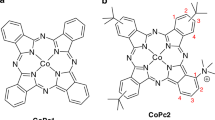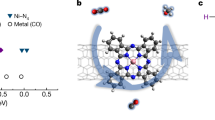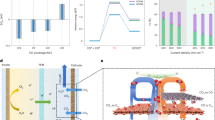Abstract
Cobalt phthalocyanine can effectively convert CO2 or CO to methanol. However, this reaction is hampered by low selectivity (a methanol Faradaic efficiency of less than 40%) and poor understanding of the kinetics and mechanism. In this work, we use a mechanism-guided reaction design approach based on systematic kinetic studies to overcome these limitations. pH-dependent Tafel analysis and kinetic isotopic effect experiments explain that methanol production from CO electroreduction is pH independent and limited by the *CO hydrogenation to *CHO step with H2O as the major proton source. Proton donor comparisons show that bicarbonate can promote the reaction at its optimal concentration of 0.1 M and CO reaction order studies confirm a Henry type isotherm for CO adsorption on the catalyst surface. These mechanistic findings lead us to carry out CO reduction in a 0.1 M bicarbonate electrolyte, under 10 atm CO pressure and with a microporous layer on the electrode to enhance reactant transport. Our reaction achieves a high methanol Faradaic efficiency of 84% with a partial current density of more than 20 mA cm−2 at −0.98 V versus the reversible hydrogen electrode, making the electrochemical CO-to-methanol conversion a selective process viable for practical application.

This is a preview of subscription content, access via your institution
Access options
Subscribe to this journal
Receive 12 digital issues and online access to articles
$119.00 per year
only $9.92 per issue
Buy this article
- Purchase on Springer Link
- Instant access to full article PDF
Prices may be subject to local taxes which are calculated during checkout





Similar content being viewed by others
Data availability
Source data are provided with this paper. All experimental data supporting the findings of this study are available in Supplementary Information.
References
Lewis, N. S. Research opportunities to advance solar energy utilization. Science 351, aad1920 (2016).
Chu, S., Cui, Y. & Liu, N. The path towards sustainable energy. Nat. Mater. 16, 16–22 (2017).
Franco, F., Rettenmaier, C., Jeon, H. S. & Roldan Cuenya, B. Transition metal-based catalysts for the electrochemical CO2 reduction: from atoms and molecules to nanostructured materials. Chem. Soc. Rev. 49, 6884–6946 (2020).
Francke, R., Schille, B. & Roemelt, M. Homogeneously catalyzed electroreduction of carbon dioxide-methods, mechanisms, and catalysts. Chem. Rev. 118, 4631–4701 (2018).
Zhang, H., Li, J., Cheng, M.-J. & Lu, Q. CO electroreduction: current development and understanding of Cu-based catalysts. ACS Catal. 9, 49–65 (2018).
Nguyen, T. N. et al. Fundamentals of electrochemical CO2 reduction on single-metal-atom catalysts. ACS Catal. 10, 10068–10095 (2020).
Dinh, C. T. et al. CO2 electroreduction to ethylene via hydroxide-mediated copper catalysis at an abrupt interface. Science 360, 783–787 (2018).
Luo, M. et al. Hydroxide promotes carbon dioxide electroreduction to ethanol on copper via tuning of adsorbed hydrogen. Nat. Commun. 10, 5814 (2019).
Xia, C. et al. Continuous production of pure liquid fuel solutions via electrocatalytic CO2 reduction using solid-electrolyte devices. Nat. Energy 4, 776–785 (2019).
Monteiro, M. C. O., Philips, M. F., Schouten, K. J. P. & Koper, M. T. M. Efficiency and selectivity of CO2 reduction to CO on gold gas diffusion electrodes in acidic media. Nat. Commun. 12, 4943 (2021).
Weng, Z. et al. Active sites of copper-complex catalytic materials for electrochemical carbon dioxide reduction. Nat. Commun. 9, 415 (2018).
Jia, L. et al. Phase-dependent electrocatalytic CO2 reduction on Pd3Bi nanocrystals. Angew. Chem. Int. Ed. Engl. 60, 21741–21745 (2021).
Guan, A. et al. Boosting CO2 electroreduction to CH4 via tuning neighboring single-copper sites. ACS Energy Lett. 5, 1044–1053 (2020).
Wang, J., Dou, S. & Wang, X. Structural tuning of heterogeneous molecular catalysts for electrochemical energy conversion. Sci. Adv. 7, eabf3989 (2021).
Wu, Y., Liang, Y. & Wang, H. Heterogeneous molecular catalysts of metal phthalocyanines for electrochemical CO(2) reduction reactions. Acc. Chem. Res. 54, 3149–3159 (2021).
Cao, R. Across the board: Rui Cao on electrocatalytic CO2 reduction. Chem. Sus. Chem. 15, e202201788 (2022).
Chang, Q. et al. Metal-coordinated phthalocyanines as platform molecules for understanding isolated metal sites in the electrochemical reduction of CO2. J. Am. Chem. Soc. 144, 16131–16138 (2022).
Soucy, T. L. et al. Considering the influence of polymer-catalyst interactions on the chemical microenvironment of electrocatalysts for the CO2 reduction reaction. Acc. Chem. Res. 55, 252–261 (2022).
Zhang, X. et al. Highly selective and active CO2 reduction electrocatalysts based on cobalt phthalocyanine/carbon nanotube hybrid structures. Nat. Commun. 8, 14675 (2017).
Zhang, X. et al. Molecular engineering of dispersed nickel phthalocyanines on carbon nanotubes for selective CO2 reduction. Nat. Energy 5, 684–692 (2020).
Guo, H. et al. Iron porphyrin with appended guanidyl group for significantly improved electrocatalytic carbon dioxide reduction activity and selectivity in aqueous solutions. Chin. J. Catal. 43, 3089–3094 (2022).
Ronne, M. H. et al. Ligand-controlled product selectivity in electrochemical carbon dioxide reduction using manganese bipyridine catalysts. J. Am. Chem. Soc. 142, 4265–4275 (2020).
Zhang, Z. et al. Reaction mechanisms of well-defined metal-N4 sites in electrocatalytic CO2 reduction. Angew. Chem. Int. Ed. Engl. 57, 16339–16342 (2018).
Soucy, T. L., Liu, Y., Eisenberg, J. B. & McCrory, C. C. L. Enhancing the electrochemical CO2 reduction activity of polymer-encapsulated cobalt phthalocyanine films by modulating the loading of catalysts, polymers, and carbon supports. ACS Appl. Energy Mater. 5, 159–169 (2021).
Wu, Y. et al. Domino electroreduction of CO2 to methanol on a molecular catalyst. Nature 575, 639–642 (2019).
Boutin, E. et al. On the existence and role of formaldehyde during aqueous electrochemical reduction of carbon monoxide to methanol by cobalt phthalocyanine. Chem. Eur. J. 28, e202200697 (2022).
Shi, L. L., Li, M., You, B. & Liao, R. Z. Theoretical study on the electro-reduction of carbon dioxide to methanol catalyzed by cobalt phthalocyanine. Inorg. Chem. 61, 16549–16564 (2022).
Boutin, E. et al. Aqueous electrochemical reduction of carbon dioxide and carbon monoxide into methanol with cobalt phthalocyanine. Angew. Chem. Int. Ed. Engl. 58, 16172–16176 (2019).
Chen, X., Wei, D. & Ahlquist, M. S. G. Aggregation and significant difference in reactivity therein: blocking the CO2-to-CH3OH reaction. Organometallics 40, 3087–3093 (2021).
Wu, Y. et al. Heterogeneous nature of electrocatalytic CO/CO2 reduction by cobalt phthalocyanines. Chem. Sus. Chem. 13, 6296–6299 (2020).
Shang, B. et al. Aqueous photoelectrochemical CO2 reduction to CO and methanol over a silicon photocathode functionalized with a cobalt phthalocyanine molecular catalyst. Angew. Chem. Int. Ed. Engl. 62, e202215213 (2023).
Su, J. et al. Improving molecular catalyst activity using strain-inducing carbon nanotube supports. Preprint at ChemRxiv https://doi.org/10.26434/chemrxiv-2022-r9r22 (2022).
Zeng, J. S., Corbin, N., Williams, K. & Manthiram, K. Kinetic analysis on the role of bicarbonate in carbon dioxide electroreduction at immobilized cobalt phthalocyanine. ACS Catal. 10, 4326–4336 (2020).
Li, J. et al. Hydroxide is not a promoter of C2+ product formation in the electrochemical reduction of CO on copper. Angew. Chem. Int. Ed. Engl. 59, 4464–4469 (2020).
Resasco, J. et al. Promoter effects of alkali metal cations on the electrochemical reduction of carbon dioxide. J. Am. Chem. Soc. 139, 11277–11287 (2017).
Zhang, G. et al. Selective CO2 electroreduction to methanol via enhanced oxygen bonding. Nat. Commun. 13, 7768 (2022).
Yang, D. et al. Selective electroreduction of carbon dioxide to methanol on copper selenide nanocatalysts. Nat. Commun. 10, 677 (2019).
Guil-Lopez, R. et al. Methanol synthesis from CO2: a review of the latest developments in heterogeneous catalysis. Materials 12, 3902 (2019).
Chang, X. et al. Tuning Cu/Cu2O interfaces for the reduction of carbon dioxide to methanol in aqueous solutions. Angew. Chem. Int. Ed. Engl. 57, 15415–15419 (2018).
Wu, Y. et al. Direct electrosynthesis of methylamine from carbon dioxide and nitrate. Nat. Sustain. 4, 725–730 (2021).
Li, J. et al. Electrokinetic and in situ spectroscopic investigations of CO electrochemical reduction on copper. Nat. Commun. 12, 3264 (2021).
Ji, Y. L. et al. Selective CO-to-acetate electroreduction via intermediate adsorption tuning on ordered Cu-Pd sites. Nat. Catal. 5, 251–258 (2022).
Overa, S. et al. Enhancing acetate selectivity by coupling anodic oxidation to carbon monoxide electroreduction. Nat. Catal. 5, 738–745 (2022).
Li, J. et al. Weak CO binding sites induced by Cu-Ag interfaces promote CO electroreduction to multi-carbon liquid products. Nat. Commun. 14, 698 (2023).
Yin, Z. et al. An alkaline polymer electrolyte CO2 electrolyzer operated with pure water. Energy Environ. Sci. 12, 2455–2462 (2019).
Fan, L. et al. Electrochemical CO2 reduction to high-concentration pure formic acid solutions in an all-solid-state reactor. Nat. Commun. 11, 3633 (2020).
Acknowledgements
This work was supported by US National Science Foundation (grant no. CHE-2154724; mechanistic and kinetic studies) and the Yale Center for Natural Carbon Capture (performance and device work).
Author information
Authors and Affiliations
Contributions
J.L. and H.W. conceived this project, designed the experiments and wrote the manuscript. J.L. and C.L.R. synthesized the catalyst materials. J.L. performed the electrochemical measurements and analysed the data. B.S., Y.G., S.C. and C.L.R. contributed to data analysis and edited the manuscript. H.W. supervised the project.
Corresponding author
Ethics declarations
Competing interests
The authors declare no competing interests.
Peer review
Peer review information
Nature Synthesis thanks Zhimin Liu and the other, anonymous, reviewer(s) for their contribution to the peer review of this work. Primary Handling Editor: Alexandra Groves, in collaboration with the Nature Synthesis team.
Additional information
Publisher’s note Springer Nature remains neutral with regard to jurisdictional claims in published maps and institutional affiliations.
Supplementary information
Source data
Source Data Fig. 2
Electrochemical testing data.
Source Data Fig. 3
Electrochemical testing data.
Source Data Fig. 4
Electrochemical testing data.
Source Data Fig. 5
Electrochemical testing data.
Rights and permissions
Springer Nature or its licensor (e.g. a society or other partner) holds exclusive rights to this article under a publishing agreement with the author(s) or other rightsholder(s); author self-archiving of the accepted manuscript version of this article is solely governed by the terms of such publishing agreement and applicable law.
About this article
Cite this article
Li, J., Shang, B., Gao, Y. et al. Mechanism-guided realization of selective carbon monoxide electroreduction to methanol. Nat. Synth 2, 1194–1201 (2023). https://doi.org/10.1038/s44160-023-00384-6
Received:
Accepted:
Published:
Issue Date:
DOI: https://doi.org/10.1038/s44160-023-00384-6
This article is cited by
-
Hybrid catalyst to the rescue
Nature Synthesis (2023)



